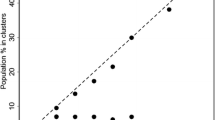Abstract
Hotspot analysis is a spatial analysis that uses cluster techniques for determining areas with elevated concentrations of localized events. We use the consolidated Extended Fuzzy C-Means algorithm to determine the hotspot areas on the map as circles, moreover the advantages of this technique are the linear computational complexity, the robustness to noise and outliers, the automatic determination of the optimal number C of clusters (in the classical FCM algorithm C is chosen a priori). Furthermore it prevents the problem of shifting the clusters with low density area of data points in areas with higher density of such points. We apply this method to study the spatio-temporal variations of the hotspot areas by testing this process on a specific disease problem, precisely we have clusterized 5,000 point-events correspondent to cases of brain cancer detected in the state of New Mexico from 1973 to 1991. We also show that the same results are obtained by using the Extended Gustafson–Kessel algorithm which gives elliptical clusters. We have implemented both algorithms in a Geographic Information System environment. Thus we establish the areas which seem not interested from the incidence of the disease and those areas in which the phenomenon appears to be temporarily attenuated either increased or constant or quite disappeared.









Similar content being viewed by others
Explore related subjects
Discover the latest articles, news and stories from top researchers in related subjects.References
Avogadri R, Valentini G (2009) Fuzzy ensemble clustering based on random projections for DNA microarray data analysis. Artif Intell Med 45:173–183
Bezdek JC (1982) Pattern recognition with fuzzy objective function algorithms. Plenum Press, New York
Chainey SP, Rei S, Stuart N (2002) When is a hotspot a hotspot? A procedure for creating statistically robust hotspot geographic maps of crime. In: Kidner D, Higgs G, White S (eds) Innovations in GIS 9: socioeconomic applications of geographic information science. Taylor and Francis, London, pp 21–36
Chertov O, Aleksandrova M (2013) Soft computing: state of the art theory. STUDFUZZ 291. In: Yager RR (ed) Fuzzy clustering with prototype extraction for census data analysis. Springer, Berlin, pp 289–313
Di Martino F, Loia V, Sessa S (2007) Extended fuzzy c-means cluste ring algorithm for hotspot events in spatial analysis. Int J Hybrid Intell Syst 4:1–14
Di Martino F, Sessa S (2009) Implementation of the extended fuzzy C-means algorithm in geographic information systems. J Uncertain Syst 3(4):298–306
Di Martino F, Sessa S (2011) The extended fuzzy C-means algorithm for hotspots in spatio-temporal GIS. Expert Syst Appl 38:11829–11836
Gath I, Geva AB (1989) Unsupervised optimal fuzzy clustering. IEEE Trans Pattern Anal Mach Intelligence 11:773–781
Gustafson DE, Kessel WC (1979) Fuzzy clustering with a fuzzy covariance matrix. In: Proceedings of IEEE Conference on Decision and Control, San Diego, pp 761–766
Kaymak U, Babuska R, Setnes M, Verbruggen HB (1997) Methods for simplification of fuzzy models. In: Ruan D (ed) Intell Hybrid Syst. Kluwer Academic Publishers, Dordrecht, pp 91–108
Kaymak U, Setnes M (2002) Fuzzy clustering with volume prototype and adaptive cluster merging. IEEE Trans Fuzzy Syst 10:705–712
Kobayashi S, Fujioka T, Tanaka Y, Inoue M, Niho Y, Miyoshi A (2010) A geographical information system using the Google API for guidance to referral hospitals. J Med Syst 34:1157–1160
Krishnapuram R, Kim J (2002) Clustering algorithms based on volume criteria. IEEE Trans Fuzzy Syst 8:228–236
Loia V, Pedrycz W, Senatore S (2004) P-FCM: a proximity-based fuzzy clustering. Fuzzy Sets Syst 148:21–41
Masulli F, Schenone A (1999) A fuzzy clustering based segmentation system as support to diagnosis in medical imaging. Artif Intell Med 16:129–147
Mullner RM, Chung K, Croke KG, Mensah EK (2004) Introduction: geographic information systems in public health and medicine. J Med Syst 28:215–221
Murray AT, McGuffog I, Western JS, Mullins P (2001) Exploratory spatial data analysis techniques for examining urban crime. British J Criminol 41:309–329
Polat K (2012) Application of attribute weighting method based on clustering centers to discrimination of linearly non-separable medical datasets. J Med Syst 36:2657–2673
Wei CK, Su S, Yang MC (2012) Application of data mining on the development of a disease distribution map of screened community residents of Taipei County in Taiwan. J MedSyst 36:2021–2027
Windischberger C, Barth M, Lamm C, Gur RC, Moser E (2003) Fuzzy cluster analysis of high-field functional MRI data. Artif Intell Med 29:203–223
Zhang DQ, Chen SC (2004) A novel kernelized fuzzy C-means algorithm with application in medical image segmentation. Artif Intell Med 32:37–50
Conflict of interest
The authors declare that they have no conflict of interests.
Author information
Authors and Affiliations
Corresponding author
Additional information
Communicated by G. Acampora.
Rights and permissions
About this article
Cite this article
Di Martino, F., Sessa, S., Barillari, U.E.S. et al. Spatio-temporal hotspots and application on a disease analysis case via GIS. Soft Comput 18, 2377–2384 (2014). https://doi.org/10.1007/s00500-013-1211-7
Published:
Issue Date:
DOI: https://doi.org/10.1007/s00500-013-1211-7




